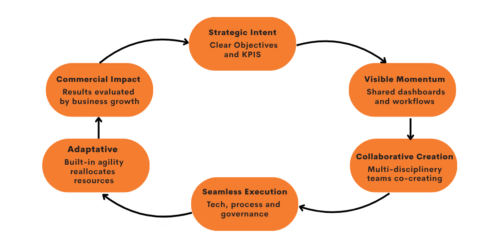Most marketing leaders recognise when a plan should be working.
A clear objective, smart channel choices, sufficient budgets. Yet often work still moves too slowly, teams feel stretched and spend doesn’t convert into momentum and business impact.
In our experience, the gap isn’t always the plan. It’s the operating system that turns intent into successful outcomes.
A robust marketing operating system isn’t an org chart or series of check boxes. It’s the framework that details how decisions get made, how the work flows, and how information and learning inform future decision making.
When the Marketing Operating System is ill-defined, the impact can be significant on process efficiencies; slow speed-to-market, competing priorities, duplicated effort and impact team performance, where lack of clarity and ownership diminishes personal influence.
What a Marketing Operating System should do
Keep momentum visible
A good OS creates transparency, who owns which stage, how long things take, and what’s holding progress back. When teams and partners have a shared view of flow, delays can be tackled early, and efficiency becomes a collective responsibility.
Make collaboration easy
Many operating systems still work based on passing briefs down a linear chain which is typically too slow.
Instead, teams should co-create briefs, review data collectively and share assets seamlessly. External partners should work to the same flow as internal teams, complimenting processes, not adding to them. Minimising handoffs so more energy can go into the work itself.
Be adaptable
As marketing continues to evolve, operating systems should reflect the pace of change and enable flexibility.
The speed of content creation continues to increase, campaign iteration cycles are shortening, and new channels appear frequently.
The best-designed operating systems anticipate this fluidity, making it easy to pivot resources, adjust decision-making, and utilise new tools so that marketing can stay responsive whilst maintaining control.
The Marketing Operating System framework

What “Good” looks like in practice
Clear governance
- Decision-making is codified and consistently applied, ensuring momentum is never lost in onerous signoffs or unclear ownership. Speed is achieved without compromising the necessary rigour.
Unified objectives and alignment
- Every team and agency partner understands how they contribute to enterprise value creation. Alignment prevents duplication and creates a common commercial language.
Frictionless operations
- Processes, tools and structures are designed around outcomes. The operating system eliminates barriers, streamlines delivery, and reallocates effort to where it drives competitive advantage.
Technology as an enabler, not a constraint
- Data, automation, and platforms are seamlessly integrated. Marketers access an agreed source of data and insight, and routine tasks automated to release creative and strategic bandwidth.
Impact measured in business terms
- Marketing effectiveness is quantified in commercial, customer and brand equity outcomes. This elevates marketing’s role from cost centre to growth driver.
Marketing that works harder
A well-designed operating system doesn’t just remove inefficiencies. It strengthens marketing’s strategic voice, gets brands to market faster, and creates the conditions for growth.
The question is no longer whether your operating system works, it’s whether it works hard enough to match your ambition.
If you are looking to create more impact from your marketing investment and would like to explore what this could mean for your organisation, we’d be delighted to continue the conversation.
At Oystercatchers we specialise in designing and optimising future-facing marketing operating systems.